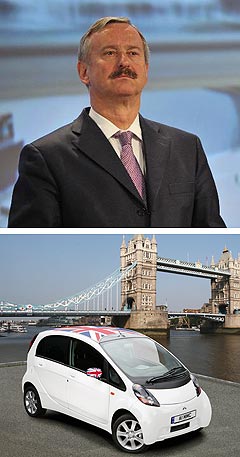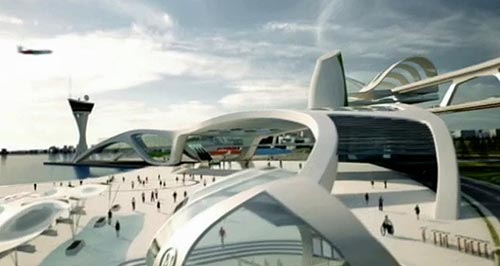Make / Model Search
News - General News - EmissionsEU seeks to ban conventional cars from cities by 2050The future's green: The European Comission has produced a video promoting its transport policy white paper. European Commission white paper wants conventionally-fuelled cars out of cities30 Mar 2011 THE European Commission has published a white paper containing recommendations for the next forty years of transport policy in the European Union, among which is the phasing out of “conventionally-fuelled” cars from cities by 2050. Qualifying conventionally-fuelled as being non-hybrid internal combustion engine-propelled vehicles, the white paper also makes recommendations for the reduction of transport-sourced pollution (particularly greenhouse gases), improvements to passenger safety and security and even working conditions for transport staff. The proposal to remove conventionally-fuelled cars from city centres has been met with scathing opposition from some motoring and political organisations in the UK, but such opposition could be short-sighted as changes to the cars people drive may well have changed by then. 2050 is 39 years away, plenty of time for hybrid, fuel-cell, and battery EV technology (and the supporting infrastructure) to develop sufficiently for the majority of internal combustion-based vehicles to be rendered obsolete. Similarly, a car built 39 years ago would today fail most emissions or safety tests and would be regarded as a dangerous relic at worst, classic at best.  Left: European Commission vice-president for transport Siim Kallas. Below: Mitsubishi i-MiEV in London. Left: European Commission vice-president for transport Siim Kallas. Below: Mitsubishi i-MiEV in London.Given that in 2011 cars like the GM Volt, Nissan Leaf and Mitsubishi i-MiEV are showing how close electric vehicles are to becoming viable for everyday use, by 2050 even older used cars are likely to have at least some form of hybrid or range-extender EV powertrain. Contrary to some accusations, the white paper makes it clear that its proposals are not designed to restrict personal mobility, recognising that mobility is vital to quality of life and that European citizens enjoy freedom of travel, which in turn “enables economic growth and job creation”. The white paper argues that, “The gradual phasing out of ‘conventionally-fuelled’ vehicles from the urban environment is a major contribution to significant reduction of oil dependence, greenhouse gas emissions and local air and noise pollution.” This sentiment was echoed by European Commission vice-president for transport Siim Kallas who said, “Curbing mobility is not an option. Nor is business as usual”. “Action cannot be delayed, infrastructure takes many years to plan and build. Trains, planes and ships last for decades. So the choices we make today will determine the shape of transport in 2050.” Proposing a single European transport area, the European Commission’s vision is to provide integrated, multi-faceted inter-city and inter-state public transport networks that provide seamless connections for travellers, backed by a freight network using “specially developed freight corridors,” limiting road-freight journeys to 300 kilometres and increases the use of rail and water-borne transport for longer distances. The white paper says that if the global goal of limiting climate change to two degrees centigrade is to be achieved, the European Union’s contribution has to be a reduction of greenhouse gases by “80-95 per cent below 1990 levels by 2050”. The transport sector’s contribution to this reduction amounts to a 60 per cent reduction in greenhouse gas emissions by 2050, with a 20 per cent reduction by 2030. According to the EU, greenhouse gas emissions from transport have risen eight per cent since 1990. The EU also says that despite advances in energy efficiency, increased volumes mean that transport, which in Europe depends on oil for 96 per cent of its energy needs, remains a large source of noise and air pollution. It paints a bleak picture of the future of Europe if action is not taken. “CO2 emissions from transport would remain one third higher than their 1990 level by 2050 Congestion costs will increase by about 50% by 2050. The accessibility gap between central and peripheral areas will widen. The social costs of accidents and noise would continue to increase.” Interestingly, despite the proposal of a Europe-wide high-speed rail network likely to reduce the market for internal flights, the white paper allows for an increase in passenger air transport – often cited as a heavy polluter – and the improved integration of airports with the rest of the public transport network. “Airport capacity needs to be optimised and, where necessary, increased to face growing demand for travel to and from third countries and areas of Europe otherwise poorly connected, which could result in a more than doubling of EU air transport activities by 2050,” the white paper says. However, one of the goals outlined in the white paper is for 40 per cent of aviation fuels to be low-carbon and sustainable by 2050.  Read more17th of March 2011  Disappointed Nissan gives up on EV lobbyingNissan now banking on incentives for zero-emissions cars in proposed carbon cap8th of March 2011  Geneva show: Car-makers have particulate problemSoot solution sought for direct-injection turbos ahead of Euro 6 |
Click to shareGeneral News articlesResearch General News Motor industry news |











Facebook Twitter Instagram